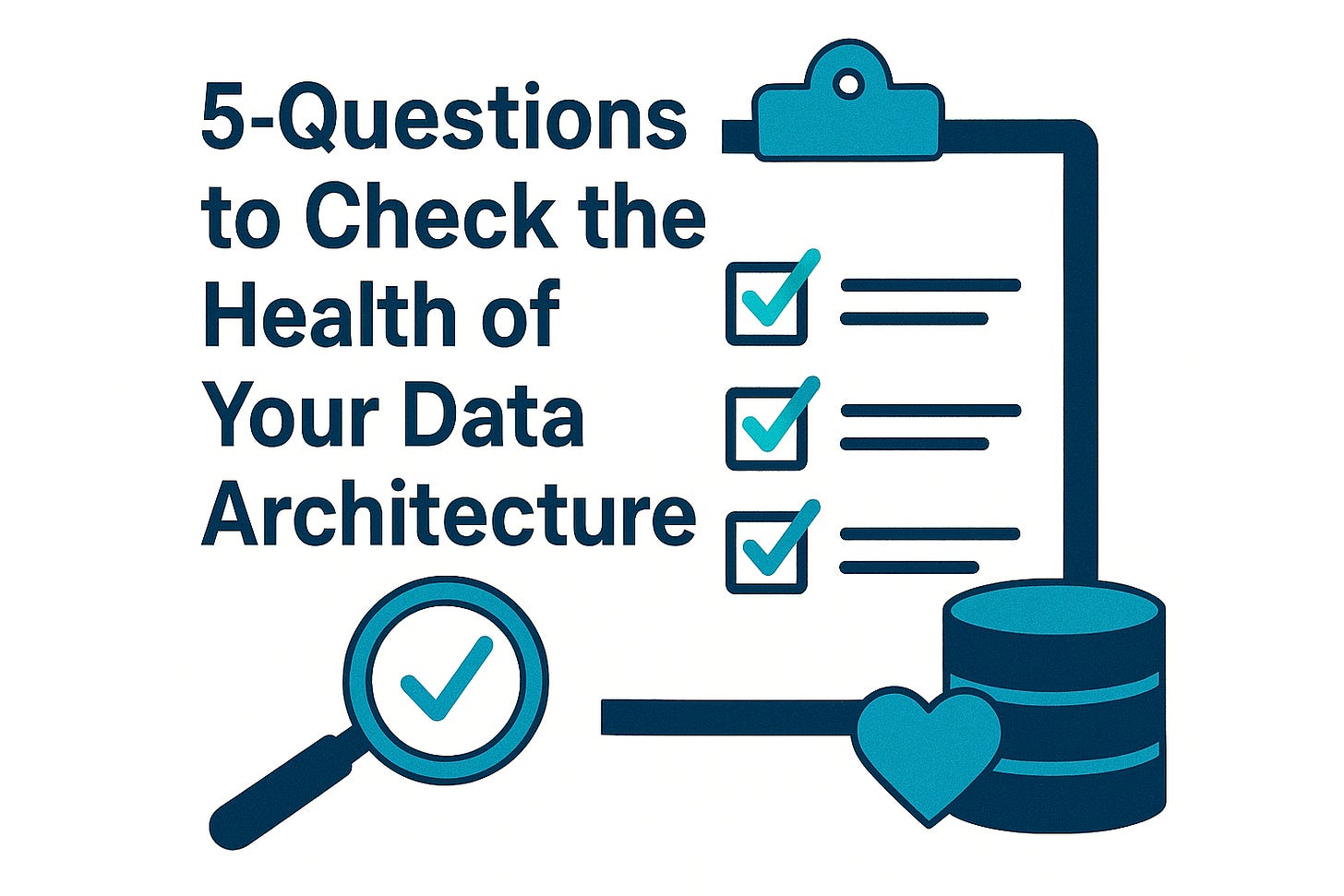#035 - 5 Signs Your Data Architecture is Failing
Don't wait for a critical failure. Ask these questions now to identify hidden risks in scalability, cost, and security.
Hi there,
Gartner recently released a sobering statistic: 45% of all product launches are delayed by at least a month.
McKinsey found that one bank delayed its system launch by 3 months, costing $8 million, due to late-stage architectural changes. Another bank completely halted its project after 18 months, during which $10 million had been invested, as the architectural complexity had become unmanageable.
The cause of these failures? Elegant, inflexible data models that function flawlessly... until business needs inevitably evolve.
Here's what Gartner won't tell you: 80% of organisations aiming to scale their digital business fail because they neglect a modern approach to data and analytics governance. The disruptive product velocity isn't caused by technical debt; it's due to architectural inflexibility.
In this week's issue:
Why dimensional models become strategic bottlenecks during business evolution
The real cost of schema inflexibility on product development timelines
5 evaluation questions that uncover whether your architecture supports or limits growth
Let's dive into what's actually happening...
If you're a CTO or Data Manager watching your team struggle to support new product features while your analytics infrastructure fails under changing requirements, then here are the resources you need to turn rigid systems into flexible platforms.
Weekly Resource List:
→ Data Architecture Trends in 2025 - DATAVERSITY (8 min read)
Deep dive into how data fabric and mesh architectures are replacing monolithic designs to eliminate IT bottlenecks
→ McKinsey: Building Data Architecture for Innovation (12 min read)
Strategic framework for adaptive platforms that enable rapid product development and market responsiveness
→ Star Schema vs Data Vault - Matillion (10 min read)
Technical comparison showing why normalised approaches outperform dimensional models for business flexibility
→ Agile Data Modelling Guide - Lonti (15 min read)
Practical methodology for building models that evolve with requirements rather than constraining them
→ Data Modernisation Strategy - Matillion (7 min read)
Strategic modernisation approach prioritising people and process over technology selection
Growth Engine or Hidden Bottleneck?
Here's the hard truth I've learned from years in the field:
The architecture patterns that made you successful yesterday become the bottlenecks that kill your competitive edge tomorrow.
At a large bank, I observed teams spend eight weeks adding customer acquisition channels to existing sales dashboards. Eight weeks. For one new dimension.
The problem wasn't the team's skill. It was the star schema's inability to evolve.
Question 1: How long does it take to add new dimensions to core business metrics?
What this reveals: Your schema's adaptability to evolving business requirements
The star schema trap:
New dimensions = rebuilt fact tables
Updated ETL pipelines
Broken downstream reports
6-8 week delivery cycles
✅ Data Vault approach:
New dimensions become satellite tables
Existing structures remain untouched
Zero impact on current reporting
2-3 day implementation cycles
The difference: Hub-Link-Satellite architecture treats change as usual, not exceptional.
Question 2: Can Your Platform Handle Real-Time Product Events Without Re-Architecting?
What this reveals: System readiness for modern product development practices
The aggregation challenge: Star schemas need pre-aggregation, which hinders real-time event ingestion. When dimension data, such as web visitor details arriving after page visits, is late, the entire aggregation process fails.
✅ Modern alternative:
Event-driven architectures with streaming platforms
Raw data capture before transformation
Real-time analytics without reliance on aggregation
Sub-second insights for product teams
Question 3: How many systems are involved in addressing a single business question?
What this reveals: The fragmentation slows strategic decisions
The silo syndrome: When launching products, executives need unified views across:
Customer acquisition data
Product usage metrics
Support ticket trends
Revenue attribution
✅ Unified data fabric approach:
Single source of truth across domains
Consistent business definitions
One dashboard, complete product picture
Question 4: What Happens When Your Business Model Evolves?
What this reveals: Architectural resilience to strategic pivots
Timeline impact: 4-month delay while rebuilding core analytics.
✅ Modular architecture principles:
Business logic separated from data structure
New business models = new business vault layers
Core data vault remains unchanged
Weeks instead of months for major pivots
Question 5: Can Teams Implement New Analytics Without Disrupting Existing Reports?
What this reveals: Platform support for continuous innovation
The deployment dilemma: Traditional architectures create zero-sum scenarios where improvement requires destruction. Adding new KPIs breaks existing dashboards because shared dimensions get modified.
✅ Parallel development capability:
Separate business vault layers for different use cases
Shared raw vault with multiple consumption patterns
Independent development tracks, zero conflicts
📊 Your Architecture Agility Score
Rate yourself on each question:
Same day implementation = 5 points
1-3 days = 4 points
1 week = 3 points
2-4 weeks = 2 points
1+ months = 1 point
Total Score Interpretation:
20-25: Architecture enables business velocity
15-19: Some constraints are manageable with planning
10-14: Significant bottlenecks affecting product timelines
5-9: Architecture is actively constraining business growth
Key Takeaways
Here's what you learned today:
Rigid schemas create architectural debt that compounds during business growth
Real-time product development requires architectures designed for change, not just performance
Strategic agility depends more on data adaptability than query speed
The companies dominating 2025 aren't those with the fastest queries—they're the ones whose data architecture adapts as quickly as their business strategy.
Your immediate action: Run through these 5 questions with your team this week. If you scored below 15, your architecture is constraining growth more than enabling it.
The fix isn't always a complete rebuild. Sometimes, it involves adding adaptive layers on top of existing systems. Sometimes it's strategic re-architecture.
The key is knowing which approach fits your specific constraints.
PS... If you're enjoying these data modernisation insights, forward this to a colleague dealing with similar architectural challenges. They'll receive frameworks for evaluating the business impact of their platform.


